Discover how decorative painting services, tailored for fine art installations, harness cutting-edge tools to elevate artistry. Today's technology offers remarkable solutions that make painting operations smoother and more efficient. This article explores key tools designed for optimizing these services.
Most of us appreciate the transformative power of a beautiful mural or accent wall, but not everyone knows about the sophisticated systems behind their creation. Read along to uncover these innovations in the world of artistic and professional painting.
1. Digital Design Platforms for Visualizing Projects
Most of us recognize that visual planning is crucial in executing stunning decorative paintings, especially when they are part of fine art installations. Digital design platforms provide a virtual canvas for artists and decorators to sketch ideas before they come to life.
These tools help capture the essence of a client's vision, offering precise previews and adjustments on the fly. Pairing these platforms with project management software streamlines communication among team members, ensuring everyone remains aligned throughout the process.
When dealing with complex artistic elements or large-scale projects, painting management software becomes invaluable. It integrates scheduling, task allocation, and resource management into one hub. This ensures not only efficient project execution but also allows creative minds to focus more on artistry rather than logistics.
2. Using Color Matching Tools for Precision
Precision in color matching often makes or breaks the success of a decorative painting project. Advanced color-matching tools simplify this task, ensuring that every hue aligns perfectly with the intended design scheme.
These devices are user-friendly and eliminate guesswork by providing exact color codes.
- Digital Spectrophotometers: Measure light absorption to deliver accurate color data.
- Color Calibration Software: Ensures monitors display consistent colors when designing digitally.
- Sample Boards: Allow physical testing of colors on surfaces to visualize final results.
These tools not only enhance accuracy but also speed up the decision-making process. Artists and painters achieve uniformity across different mediums, making installations more cohesive.
The right tools lead to professional-grade outcomes while reducing errors in execution, elevating overall service quality.
3. Essential Safety Gear and Equipment in Painting
When working on decorative projects, especially those involving fine art in building constructions, safety remains paramount. Artists need to safeguard against risks inherent in working with paints, solvents, and ladders.
Fundamental protective wear encompasses gloves to block chemical contact with the skin and masks designed to sift out noxious fumes.
Eye protection shields against splashes or dust during surface preparation. Robust scaffolding affords a stable base to access elevated spaces securely, without sacrificing steadiness. Footwear designed to prevent slips is equally essential when traversing slick areas such as freshly coated floors.
Adopting such safety strategies not only preserves well-being but also enhances productivity by enabling painters to devote their full attention to the craftsmanship at hand, free from concern. By prioritizing safety through appropriate gear, artists contribute positively to the longevity of their work environment.
4. Techniques for Efficient Surface Preparation
Proper surface preparation ensures a smooth finish, which is vital in decorative painting services. By using effective techniques, painters create a foundation that enhances the durability and appearance of the final product.
- Cleaning: Remove dust, dirt, and grease to ensure paint adhesion.
- Sanding: Smooth out imperfections for an even surface.
- Priming: Apply primer to seal surfaces and improve paint bonding.
Painters can also use chemical strippers on stubborn old layers or employ pressure washing for large outdoor surfaces. Tackling repairs like filling cracks or holes before applying any coatings maintains structural integrity.
These methods collectively optimize results by reducing rework caused by overlooked flaws. An efficiently prepared surface sets the stage for superior quality work while minimizing project delays or setbacks due to unforeseen issues.
5. Embracing Eco-Friendly Methods in Painting Endeavors
The painting industry's methods are evolving, with a particular nod toward sustainability in the realm of fine art projects. Opting for low-VOC, environmentally benign paints curtails noxious emissions, benefiting both the atmosphere within homes and the health of residents and painters.
Opting for water-based alternatives to oil-based paints provides a comparable quality without the toxicity. Responsible recycling habits and appropriate disposal techniques for surplus materials further diminish environmental footprints.
Choosing vendors committed to eco-friendly production processes amplifies these green initiatives. Energy-efficient equipment and lighting contribute to resource conservation, and training employees in eco-conscious techniques guarantees uniformity in sustainable practices.
By weaving these green threads into their fabric of operation, painters not only improve their service attractiveness but also align with a critical consumer shift toward businesses that champion ecological integrity and perpetuate planetary health.
Concluding Thoughts on Enhanced Painting Practices
Innovative tools and practices transform the landscape of decorative painting services, especially in fine art installations. By leveraging technology and sustainable methods, artists and decorators elevate their craft to new heights.
As these enhancements become integral to operations, professionals ensure projects are executed efficiently, meeting high standards while satisfying growing expectations for quality and environmental responsibility.
